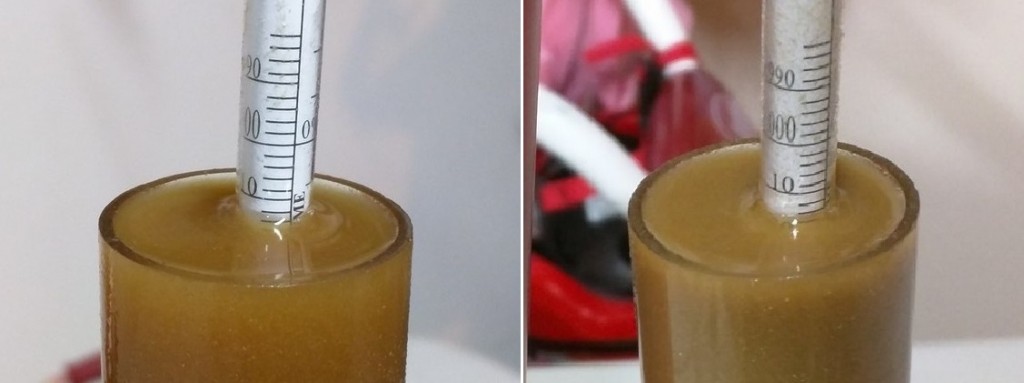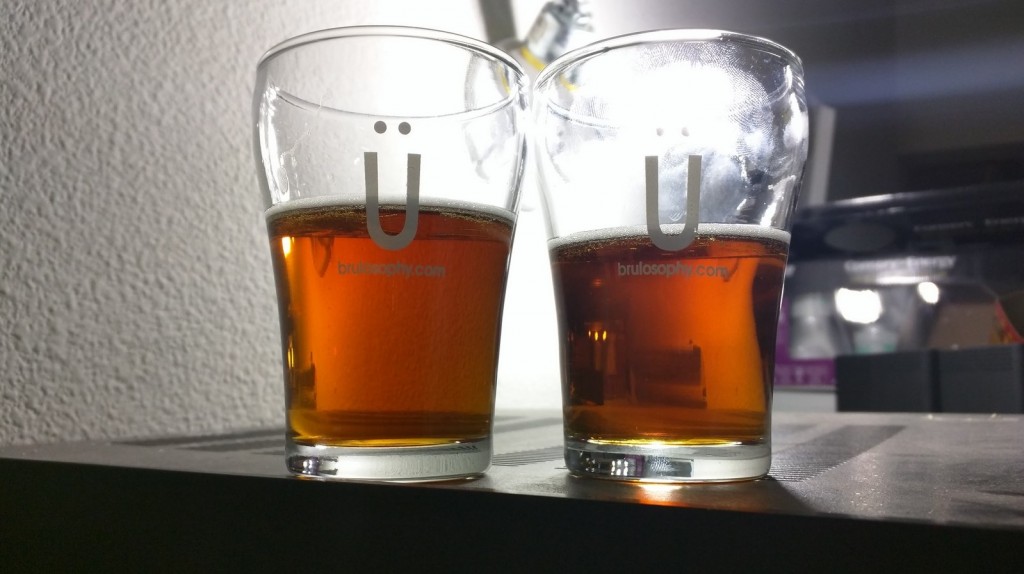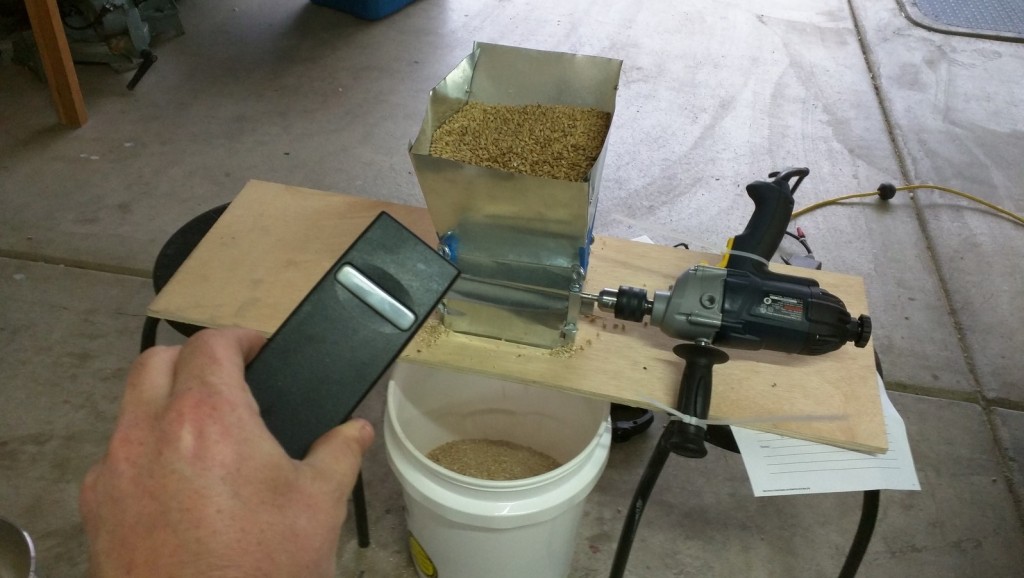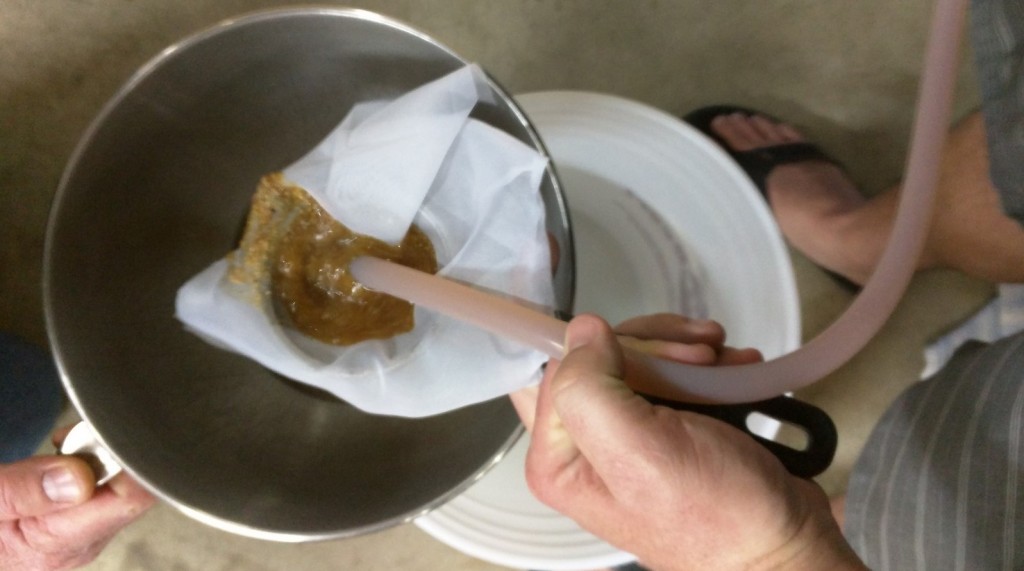Author: Ray Found
When I started brewing, I learned one does not drain the wort from the grains without performing a vorlauf, that is, recirculating sweet wort until it runs clear. It was deemed a requirement that contributes to the full extraction of sugar from the grains, help set the grainbed for effective lautering, and prevent astringency producing grain husks from making their way into the boil kettle. I initially learned about the horror of husks while reading comments about the now infamous Good Eats episode where Alton Brown boiled his steeping grains with extract and hops. Tannins!
It makes sense to me that grain husks might impart some flavor that is different than the endosperm it encases, after all, whole grain bread does taste different than white bread. However, the results from our first vorlauf xBmt showed that tasters could not reliably distinguish between a beer that had undergone a vorlauf from one that hadn’t, making me wonder if perhaps the amount of grain making it to the boil played a role.
We tend to focus our xBmts on the practical, but occasionally a time comes where testing extremes could potentially yield more meaningful information. That time is now.
| PURPOSE |
To evaluate the differences between a beer brewed with a standard vorlauf where very little grain material made it to the boil and another of the same recipe where an extreme amount of spent grain was added to the boil.
| METHOD |
Due in no small part to my difficulty finding Negra Modelo on tap, a beer I’ve no shame admitting I thoroughly enjoy, I put together a recipe for a Vienna Lager, it would be my first attempt at brewing this style.
Vienna Lager
Recipe Details
| Batch Size | Boil Time | IBU | SRM | Est. OG | Est. FG | ABV |
|---|---|---|---|---|---|---|
| 11 gal | 90 min | 21.7 IBUs | 10.3 SRM | 1.049 | 1.009 | 5.2 % |
| Actuals | 1.046 | 1.011 | 4.6 % | |||
Fermentables
| Name | Amount | % |
|---|---|---|
| Vienna Malt (Gambrinus) | 12.15 lbs | 60 |
| Pilsner (2 row) (Gambrinus) | 5.062 lbs | 25 |
| Munich Light 10L (Gambrinus) | 2.632 lbs | 13 |
| Pale Chocolate Malt | 6.48 oz | 2 |
Hops
| Name | Amount | Time | Use | Form | Alpha % |
|---|---|---|---|---|---|
| Hallertau Magnum | 23 g | 60 min | Boil | Pellet | 12.1 |
| Hallertauer | 56 g | 10 min | Boil | Pellet | 3.2 |
Yeast
| Name | Lab | Attenuation | Temperature |
|---|---|---|---|
| German Ale/Kolsch (WLP029) | White Labs | 75% | 65°F - 69°F |
Download
| Download this recipe's BeerXML file |
For this variable, we determined splitting the wort post mash would increase consistency between the batches, so I performed a standard batch sparge. My brew day began with the heating of strike water, during which I set to the task of weighing out and milling my grain. I’d recently received a new mill and, in my excitement to use it, fashioned up a sheet metal version of my own hopper since the real one hadn’t arrived yet… pretty is not the right word.
The mill outperformed its shitty looks and chewed through 20 lbs of grain in under 2 minutes. I transferred the over-heated strike water to my mash tun, allowing it to preheat for a couple minutes.

Once the liquor had dropped to my target strike temp, I mashed in and came just shy of my intended mash temperature.
I pulled a sample of sweet wort from the mash after about 10 minutes and found it sitting right at what what was estimated by the Bru’n Water spreadsheet.
I’ve always wondered just how much grain is really being filtered out during a vorlauf, so my friend Dave, owner/brewer of Stone Church Brewing in Corona, CA, and I measured it by running the vorlauf wort through a strainer rather than directly back on top of the grainbed.
After recirculating approximately 1.5 gallons of sweet wort, I weighed the detritus– roughly 23 grams/0.8 ounces of grain material. Since I was batch sparging, which involves adding another volume of sparge water and stirring, it can be assumed this proportion would effectively be matched by the vorlauf prior to collecting the second runnings, equaling upwards of 50 grams/1.8 ounces from an 11 gallon batch that would have otherwise made it to the kettle. Albeit, the grains were wet, but still, that seems like a lot. After collecting the entire volume of wort from the mash, I stirred it well then split it into two 6.75 gallon portions, both grain-free. At this point, I decided to simulate a worst-case-scenario and added nearly 200 grams/7 ounces of spent grain directly to one of the boil kettles. No one could vorlauf this badly.
I noticed a difference between the two batches immediately after a boil was reached, with the extreme batch developing a big scab of shit floating on top. Frankly, it looked gross.
Once the boils were complete, I quickly chilled the wort and transferred each batch to matching 6 gallon PET carboys, placing them in my fermentation chamber to finish chilling. Hydrometer measurements at this point revealed the beers were at the same 1.046 SG. A few hours later, the worts had stabilized at my target fermentation temperature of 58°F/14°C, so I split the starter of yeast between the batches. They were chugging along nicely when I checked on them 36 hours later.
After a week, I began ramping the temperature in the chamber to 72°F/22°C where they remained for another week. With no signs of activity, I took hydrometer measurements and discovered both had finished at 1.011 SG.

I proceeded to cold crash, fine with gelatin, and kegged both batches. After about two weeks in my keezer on gas, the beers were clear, carbonated, and ready for evaluation.

| RESULTS |
The bulk of the data for this xBmt was collected at Wagon Wheel Tavern during a BeerMe Brew Club meeting and included 23 participants in total. While 12 tasters (p<0.05) would have had to correctly identify the odd sample out to achieve statistical significance, only 11 (p=0.107) chose the correct sample, suggesting this panel was not able to reliably distinguish between a beer produced using a standard vorlauf and one that had a shit ton of spent grain added to the boil. And though it may not matter, preference among those who were correct on the triangle test was split.
My Impressions: Yuck! When the beer was freshly kegged, before I began serving them to others, I absolutely hated the boiled-grain batch. It tasted strange and had a “twang” to it that reminded me a bit of liquid malt extract, not at all clean or crisp. It just wasn’t good. When I returned to it over a week later, I could still consistently tell the beers apart in multiple “blind” triangles, perhaps biased by my earlier experience. However, the distinct character I initially got from the boiled grain batch was gone and I had no clear preference by the time I administered survey. Moreover, I didn’t experience any of the astringent tannin character I expected, which genuinely shocked me.
| DISCUSSION |
For a second time, an xBmt has supported the idea that the vorlauf step may not be as vital as many of us have have come to believe, even when taken to a drastic extreme not likely to occur in the typical homebrewery, with one exception…
The decoction method involves taking large portions of the mash and boiling it upwards of three times before returning it to the mash. While I’ve read numerous arguments for and against the merits of decoction, one thing I’ve yet to encounter are reports of people perceiving decocted beers as astringent. It’s curious to me that many of the same people who boil heaps of grain later invest such effort in making sure all of that grain remains in the mash tun.
I also wonder about the possibility of a combined variable effect, in this case the time the beer spent lagering. While initially the two beers tasted quite different to me, with the boiled grain batch having a twang that could maybe have been related to tannins, it seemed to diminish substantially over time. It makes sense to me that astringency causing particulate would precipitate during the lagering phase.
In the end, I won’t be dropping the vorlauf step from my brewing routine, if only because I perceived the beer made using my normal process as being better when fresh and I’m slightly impatient. That being said, even with such a large proportion of grain added to the boil, the difference was minor enough to lend credence to the idea that a vorlauf isn’t a vital procedure to make good beer.
If you have any thoughts about this xBmt, please do not hesitate to share in the comments section below!
New Brülosophy Merch Available Now!
Follow Brülosophy on:
FACEBOOK | TWITTER | INSTAGRAM
If you enjoy this stuff and feel compelled to support Brulosophy.com, please check out the Support page for details on how you can very easily do so. Thanks!


















28 thoughts on “exBEERiment | Impact Boiling Spent Grain In Wort Has On A Vienna Lager”
Very interesting results. I wonder what the limit would be for an amount of grain needed to reach significance would be.
Is there a measurable chemical that is present that could be tested for that’s specific to grain and beer? I quite often perceive a tea like tannin quality in my decoction beers when they’re still very young, as soon as I get them in bottles and they’re properly conditioned and aged it goes away(literally surprises me every time I open a bottle that the astringency is gone).
Could be that this is a homebrew vs. commercial thing. At a commercial scale 7oz becomes an entire sack of grain being boiled. Also I’d bet the age of the beer plays a significant role so knocking out beers quickly to sell them plays a part, homebrewers aren’t concerned with getting the beers out as fast as possible.
“homebrewers aren’t concerned with getting the beers out as fast as possible”
Hahaha… I am not heralded the world over for patience!
It sounds like just a larger sample size would make these results significant, probably another ten or so people.
Maybe. You really can’t extrapolate like that though, given statistics.
You could, however, choose to say for your own interpretation that the Author’s Experience combined with p=.107 would satisfy your personal threshold for ‘counting’, and decide that “boiled grain likely has an effect”.
Sometimes I get a similar scab during the boil, but I haven’t detected anything wrong with those batches…
I have experienced a similar issue, where a very young beer (irish ale only 2-weeks from brew to tap) started out tasting way too astringent, but the astringency went away over a couple weeks in the keggerator. I was worried that I had screwed something up, but as you posit, the problematic materials may have precipitated and settled out.
@he who must not be named….The main chemical that is thought to be responsible for “husky” or astringent flavors is aldehyde cyclopentyl methanol. So much of our brewing practice is based on brewing tradition, so many of our brewing ingredients have improved so much over the years that the traditions aren’t quite as important as they once were. There was a time when malt husks seemed thicker and more a part of the grist than they now seem. I haven’t actually studied this but it is what my memory tells me based on 27-years of home brew. I believe that there was a time when this would have mattered. But I think like undermodified grains… grains with lots of ACM in the husk have gone by the way side. I don’t know this, I just suspect it.
I got three words – HFS!
Reading this, it made me think about how people fetishize clarity in their beer for appearance sake, but part of the point of clarity should be to tell you when your beer is ready in terms of taste. Skipping lagering and just hitting beer with gelatin for example, is merely an appearance hack, and you didn’t give things that are unaffected by gelatin time to settle out.
One could also argue that if you alter your process to ensure that there are no off flavors to begin with, you don’t need to bother lagering and can save time by adding finings. I’m fine with this approach too, as long as the brewer knows why they are doing these things.
I’m admittedly vain about beer appearance. I am not convinced gelatin is ONLY an appearance hack, but it is largely for appearance.
Would be interesting to see whether fining with gelatin helped accelerate the precipitation of undesirable flavor compounds. Perhaps conditioning without fining would take significantly longer to reduce the twang.
I have skipped vorlauf and found no noticeable issues with the beers. Granted these were ambers and pales with lots of flavors that could mask issues. I would like to try it on a super clean lager before I make judgments on it.
New band name: Big Scab of Shit
I wonder if the results would have been affected if you chose to forego the gelatin addition.
Difficult to say.
I’d be curious to see you guys do an astringency exBEERiment where you do one of the big no-no’s wether it’s sparging really hot, over sparging, having high bicarbonate’s etc…
I’ve also wondered if Gelatin has an affect on removing astringency from beer. From anecdotal experience, I swear I’ve fixed a puckering beer with gelatin, could have also been fixed by the time spent lagering in the keg. An interesting observation I made with this particular beer was when a friend of mine disturbed the keg; I poured a slightly cloudy pint and boom, astringent taste came back until the beer poured clear again.
I suspect no on the sparging really hot. My bocks/dopplebocks I do BiaB just like all my other brewing. Well I do a single doccotion (I forget the method name now). Basically my normally BiaB I mash/lauter in my 6gallon pot with about 2/3rds of the liquor and then transfer to my 5gallon pot with the other 1/3rd at 165-170F for 10-15 minutes. That tends to get me 77-82% efficiency depending on the gravity of the beer with my grain crushed with my corona mill set pretty fine.
Well Bocks and Dopplebocks I tend to do the 2nd steeping of the grains after primary lautering with only enough water to just barely cover the grain and then I’ll crank it up to a hard boil for 20minutes and then filter everything through my grain bag (because I don’t want to chance melting it letting it sit in the bottom of a boiling pot).
To brag, I make a really nice bock/dopplebock and they are extremely smooth. There is definitely no astringency even though I am boiling 100% of my grain for 20minutes at a very hard boil.
Last weekend I brewed a Augustiner Lagerbier Hell and I managed to get a few handfuls of grain in the boil. I used some Melanoidin malt. I was researching my options for finding organic Melanoidin or doing a decoction as I worried about my fermenting beer and how I may have ruined it. Then I wondered…isn’t decoction the same thing(in a way) that I did? This article makes me think the beer will turn out just fine. Especially after a couple weeks of lagering! Thanks!
It’s interesting to see how often you guys say that you are not going to change your brewing process despite the fact that the Xbmt that you yourself just ran suggests that you could change your process with little to no ill effects. I understand in this case that you noticed some astringency in your young beer and that is your reason for not changing. Fair enough. But it also suggests that you, like many others, may be having a hard time breaking away from the same brewing dogma that you are challenging with your experiments.
You’re absolutely right. Now in this case, I think there is good reason for me to continue with vorlauf, based on my own perceptions.
That being said, it is wrong to conclude from this test that “Vorlauf doesn’t matter” – we just can’t say that from this trial. The strongest interpretation we can really apply is that “We did not prove that vorlafing does matter”.
But the other reason we don’t often change based on a single trial, is that we don’t know (yet) how some of these variables may compound when taken together, so I keep my baseline brewing generally unchanged. That being said, I actually HAVE changed some things as a result of xbmts:
1. Starters: I don’t think twice about a 4-6 hour “Vitality” starter, instead of building up the “Required” cell counts.
2. I didn’t make the switch to clarity ferm from gelatin because I didn’t like the performance as well.
3. I am generally mashing higher than I used to, because mash temperature didn’t seem to have the character impact on my finished beer I used to believe, but it can cut the abv a couple percentage points. I am also less concerned with absolute mash precision for the same reasons. A year ago, I would have used Ice packs to lower a mash I intended to be 152. if it settled in at 154… now, I don’t even consider it.
4. I continue to dry hop warm, and with high quantities of hops.
So I absolutely AM making some changes to my procedures as we learn things…
I’ve certainly changed a few things based on what I’ve learned here. The dry hopping warm for a couple of days before I cold crash is one of them (instead of dry hopping when I cold crash). The shorter lagering is another (I typically do 7 days at lager temps, 3 days at room temp in the mid to high 60F range and then 7 days at 35F and bottle). I also don’t worry about dumping all my kettle trub in to the carboy.
I also don’t sweat cell counts as much. I always make a starter, but that is because my process is making an oversized starter and no guarantee that what I saved off from the last time is still viable. Every cell line I’ve had that has had more than 6 “uses” out of it has died in some manner. Which means about 12-18 months before the cell line goes reticulum up.
WLP090, WLP005 and WLP830 were my three longest running cell lines and all 3 died within about 2 months of each other just a few months ago. I had the WLP005 die earlier, so I was actually on fresh test tube #2 when this line died.
I got 3 batches of use out of my original WLP005 and then 5 out of the new one (I use WLP005 a lot). I got 6 uses out of WLP090 and 5 out of WLP830 before they died.
I kind of suspect it might have been something with where the test tubes were located in my fridge. Only reason I can come up with that all three lines would die within such a short period of time. 2 failed to ferment at all after 48hrs and 1 fermented right away…but as pure lacto (actually I should have kept it, because it was a really nice lactobacillus strain).
Anyway, this is why I prefer to do a full starter. Make sure my yeast is still viable (I have now dry yeast as a back-up and I haven’t used dry yeast in ~2yrs) just in case I need a back-up plan for my brew.
Test comment for Vimeo bug:
1 2 3 4 5 6 7 8 9 10 11 11 11
I’ve read a couple of sources that say tannins are not extracted from husks at low ph levels. Since the mash ph is normally 5-5.5 this inhibits tannin extraction. Try dropping your grains in clean boiling water! This is a big issue for extract Brewers who use specialty grains as to not boil the grains.
I’m a first year brewer. My first 3 beers were 1 gallon, all-grain kits from Sharper Image… imagine that. Those batches produced cloudy beer for a lot of reasons (tasted o.k., but cloudy). Graduating up to 5 gallon batches I wanted to do everything possible to produce clear or clearer beer and while vorlauf-ing may not have an influence on the final beer’s clarity, it makes me feel like I’m doing everything possible to create a clear beer, and that’s enough for me. I might be late to the party, but I thoroughly enjoy reading your xBmts!
I am looking for a good Vienna Lager recipe.Were you happy with the recipe of this beer? Would you change any of the ingredients or amounts?
Modelo Negra, according to their website, is a Munich Dunkel not a Vienna Lager. Just a FYI
Currently listening to the podcast and the whole time, I’m sitting here thinking that pretty much all German beers used to be decoction mashed and you never get tannin from those beer styles. I was on fire to come in here and point it out. But dammit….. you mentioned it in the write up and stole my thunder.
So. Beyond my disappointment at not being able to point out a novel counterpoint, those German styles are also well known for being aged or lagered for long periods of time before serving. So it seems to match well with your experience as well.
I’m curious if you had any burned grains at the bottom of your boil. It’s one thing to boil grains, but often grains will scorch at the bottom, and when you finally transfer your beer into the fermenter, you will see black grains.
Vorlauf is also said to “set” the gain bed making for a better runoff/ sparge.
When I first started brewing, many,many years ago, I remember vorlafing for ever, trying to get my run off clear.. It took me awhile to realise it meant clear of grains. Not crystal clear wort!
I still think newcomers might make the same assumption but maybe I’m just thick!